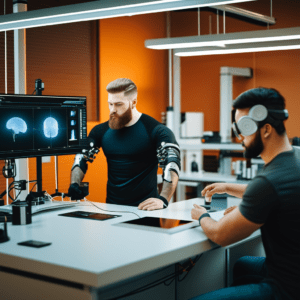The Augmented Path: From Novice to Expert in Human Augmentation Careers
Human augmentation, the integration of technology into the human body to enhance physical and cognitive abilities, is a rapidly growing field with exciting career opportunities. From entry-level positions to senior roles, there are numerous career paths available for those interested in this cutting-edge field.

- Entry-Level Positions
- Mid-Level Positions
- Senior Positions
- Education and experience requirements
- Industries
- Skills and qualities
- Conclusion
Entry-Level Positions
For individuals starting their journey in human augmentation, entry-level positions provide a solid foundation. These positions typically require a bachelor’s degree in a relevant field such as biomedical engineering, computer science, or neuroscience. Some common entry-level roles include:
- Research assistant: Research assistants work under the supervision of more experienced scientists and engineers to conduct research on human augmentation technologies. They may help with tasks such as data collection and analysis, experimental design and execution, and report writing.
- Technician: Technicians are responsible for the day-to-day operation and maintenance of human augmentation equipment. They may also be involved in the development and testing of new technologies.
- Engineer: Engineers design, develop, and test human augmentation technologies. They may work on a variety of projects, such as developing new brain-computer interfaces, exoskeletons, or retinal implants.
- Software developer: Software developers create and maintain the software that powers human augmentation devices and systems. They may work on developing new control algorithms, data processing software, or user interfaces.
- Clinical research coordinator: Clinical research coordinators oversee clinical trials of human augmentation technologies. They are responsible for managing all aspects of the trial, from recruiting participants to collecting data and analyzing results.
Mid-Level Positions
As professionals gain experience and expertise in human augmentation, they can progress to mid-level positions that offer more responsibility and leadership opportunities. These roles often require a master’s degree or equivalent experience. Some mid-level positions in human augmentation include:
- Project manager: Project managers are responsible for planning, executing, and monitoring human augmentation projects. They work with a team of engineers, scientists, and other professionals to ensure that projects are completed on time and within budget.
- Scientist: Scientists conduct research on human augmentation technologies. They may work on developing new materials, algorithms, or devices. They may also be involved in clinical trials of new technologies.
- Engineer: Engineers design, develop, and test human augmentation technologies. They may work on a variety of projects, such as developing new brain-computer interfaces, exoskeletons, or retinal implants.
- Software developer: Software developers create and maintain the software that powers human augmentation devices and systems. They may work on developing new control algorithms, data processing software, or user interfaces.
- Clinical research associate: Clinical research associates oversee clinical trials of human augmentation technologies. They are responsible for collecting data from participants and monitoring their safety.
- Regulatory affairs specialist: Regulatory affairs specialists ensure that human augmentation technologies comply with all applicable regulations. They work with regulatory agencies to obtain approval for new technologies and to ensure that existing technologies are safe and effective.
Senior Positions
Senior positions in human augmentation require extensive experience, expertise, and leadership skills. These roles often involve leading teams, driving innovation, and shaping the future of the field. Some senior positions in human augmentation include:
- Director of research and development: Directors of research and development oversee the research and development of human augmentation technologies. They work with a team of scientists and engineers to develop new technologies and improve existing technologies.
- Principal scientist: Principal scientists are leading experts in human augmentation research. They conduct research on new technologies and lead teams of other scientists.
- Chief engineer: Chief engineers are responsible for the overall design and development of human augmentation technologies. They work with a team of engineers to ensure that technologies are safe, effective, and affordable.
- Software architect: Software architects design and develop the software architecture for human augmentation devices and systems. They work with a team of software developers to ensure that the software is scalable, secure, and maintainable.
- Vice president of clinical research: Vice presidents of clinical research oversee all clinical trials of human augmentation technologies. They are responsible for ensuring that trials are conducted ethically and that the data collected is accurate and reliable.
- Chief regulatory officer: Chief regulatory officers are responsible for ensuring that human augmentation technologies comply with all applicable regulations. They work with regulatory agencies to obtain approval for new technologies and to ensure that existing technologies are safe and effective.While the specific educational requirements may vary for each position, a strong foundation in science, technology, engineering, or mathematics (STEM) is essential. Additionally, candidates with interdisciplinary backgrounds, such as a combination of engineering and biology, are highly valued in the field of human augmentation.
Education and experience requirements
The education and experience requirements for human augmentation careers vary depending on the specific position. However, most positions require at least a bachelor’s degree in a related field, such as engineering, computer science, or biology. Some positions may also require a master’s degree or Ph.D.
In addition to education, many positions also require relevant experience. This experience can be gained through internships, volunteer work, or previous employment in the field.
Industries
Candidates from a variety of industries are valued for human augmentation careers. However, some of the most relevant industries include:
- Medical devices
- Pharmaceuticals
- Biotechnology
- Healthcare
- Technology
Skills and qualities
In addition to education and experience, there are a few other skills and qualities that are important for a successful career in human augmentation. These include:
- Strong analytical and problem-solving skills
- Ability to work independently and as part of a team
- Excellent communication and interpersonal skills
- Attention to detail
- Passion for human augmentation and its potential to improve lives
Conclusion
Human augmentation is a challenging but rewarding field with the potential to make a real difference in the world
As the field of human augmentation continues to evolve, professionals from various industries are finding opportunities to contribute their expertise. Industries such as biomedical engineering, robotics, neuroscience, and artificial intelligence are particularly valued for their unique perspectives and skills.
Whether you are just starting your career or looking to advance in the field of human augmentation, there are diverse and exciting career paths available. By acquiring the necessary education, gaining relevant experience, and staying updated on the latest advancements, you can embark on a fulfilling career in this transformative field.







